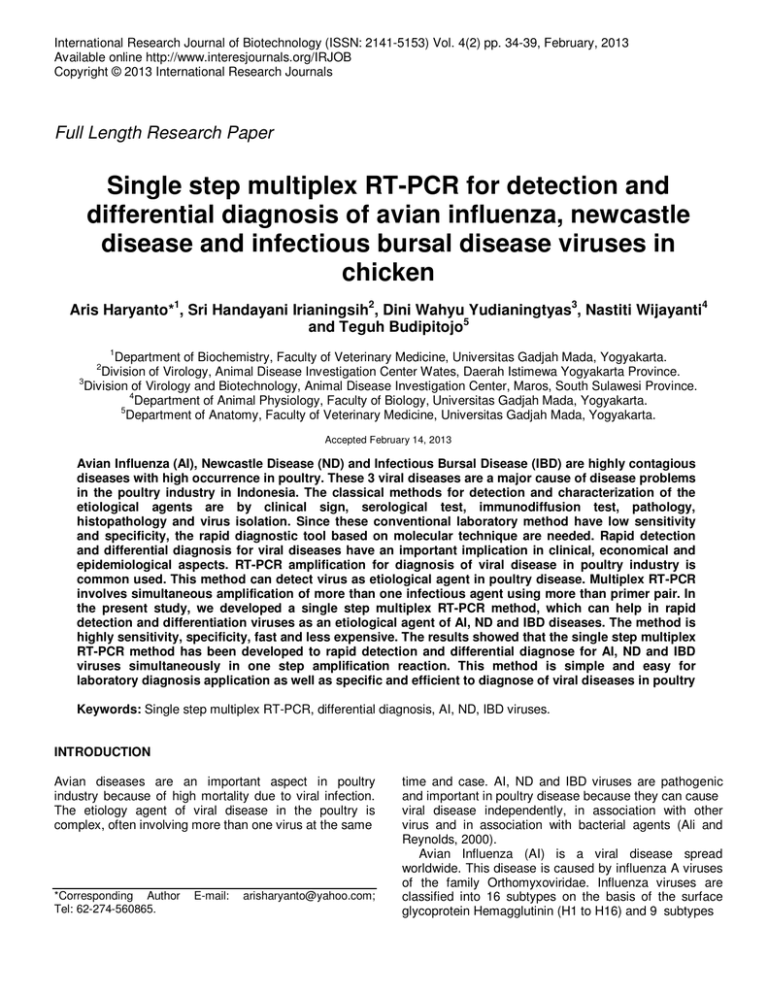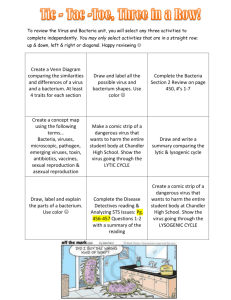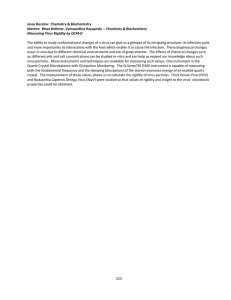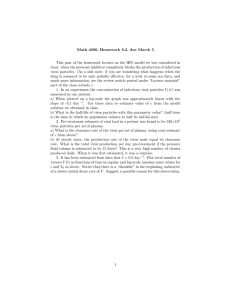Document 14262796
advertisement

International Research Journal of Biotechnology (ISSN: 2141-5153) Vol. 4(2) pp. 34-39, February, 2013 Available online http://www.interesjournals.org/IRJOB Copyright © 2013 International Research Journals Full Length Research Paper Single step multiplex RT-PCR for detection and differential diagnosis of avian influenza, newcastle disease and infectious bursal disease viruses in chicken Aris Haryanto*1, Sri Handayani Irianingsih2, Dini Wahyu Yudianingtyas3, Nastiti Wijayanti4 and Teguh Budipitojo5 1 Department of Biochemistry, Faculty of Veterinary Medicine, Universitas Gadjah Mada, Yogyakarta. Division of Virology, Animal Disease Investigation Center Wates, Daerah Istimewa Yogyakarta Province. 3 Division of Virology and Biotechnology, Animal Disease Investigation Center, Maros, South Sulawesi Province. 4 Department of Animal Physiology, Faculty of Biology, Universitas Gadjah Mada, Yogyakarta. 5 Department of Anatomy, Faculty of Veterinary Medicine, Universitas Gadjah Mada, Yogyakarta. 2 Accepted February 14, 2013 Avian Influenza (AI), Newcastle Disease (ND) and Infectious Bursal Disease (IBD) are highly contagious diseases with high occurrence in poultry. These 3 viral diseases are a major cause of disease problems in the poultry industry in Indonesia. The classical methods for detection and characterization of the etiological agents are by clinical sign, serological test, immunodiffusion test, pathology, histopathology and virus isolation. Since these conventional laboratory method have low sensitivity and specificity, the rapid diagnostic tool based on molecular technique are needed. Rapid detection and differential diagnosis for viral diseases have an important implication in clinical, economical and epidemiological aspects. RT-PCR amplification for diagnosis of viral disease in poultry industry is common used. This method can detect virus as etiological agent in poultry disease. Multiplex RT-PCR involves simultaneous amplification of more than one infectious agent using more than primer pair. In the present study, we developed a single step multiplex RT-PCR method, which can help in rapid detection and differentiation viruses as an etiological agent of AI, ND and IBD diseases. The method is highly sensitivity, specificity, fast and less expensive. The results showed that the single step multiplex RT-PCR method has been developed to rapid detection and differential diagnose for AI, ND and IBD viruses simultaneously in one step amplification reaction. This method is simple and easy for laboratory diagnosis application as well as specific and efficient to diagnose of viral diseases in poultry Keywords: Single step multiplex RT-PCR, differential diagnosis, AI, ND, IBD viruses. INTRODUCTION Avian diseases are an important aspect in poultry industry because of high mortality due to viral infection. The etiology agent of viral disease in the poultry is complex, often involving more than one virus at the same *Corresponding Author Tel: 62-274-560865. E-mail: arisharyanto@yahoo.com; time and case. AI, ND and IBD viruses are pathogenic and important in poultry disease because they can cause viral disease independently, in association with other virus and in association with bacterial agents (Ali and Reynolds, 2000). Avian Influenza (AI) is a viral disease spread worldwide. This disease is caused by influenza A viruses of the family Orthomyxoviridae. Influenza viruses are classified into 16 subtypes on the basis of the surface glycoprotein Hemagglutinin (H1 to H16) and 9 subtypes Haryanto et al. 35 on the basis of the glycoprotein Neuraminidase (N1 to N9). Protein H and N of AI virus are highly variable; therefore, a great number of AI virus (AIV) subtypes occur (Fouchier et al., 2005). Influenza virus type A causes widespread and fatal disease in birds as well as mammals, including humans. Amino acid sequence identity among subtypes of HA and NA ranges from 2580% and 42-57%, respectively (Colman et al., 1983). All influenza A virus subtypes have been found in aquatic and domesticated birds, and a few subtypes have been recovered from mammals (Pantin-Jackwood and Swayne, 2009). Influenza A viruses that have infected humans during the past 90 years have been limited to the H1, H2, and H3 subtypes. However, human infections with several AI subtypes such as H5N1, H7N7, and H9N2 have occurred, thus demonstrating direct crossing of the species barrier (Peiris et al., 2004; Koopmans et al., 2004; Butt et al., 2005). Newcastle Disease (ND) is an infectious viral disease of poultry which has a serious economic impact on poultry industry. The etiological agent of ND disease is a member of avian paramyxoviruses (APMV), which are classified into the Avulavirus genus and Paramyxoviridae family (Abolnik et al., 2004). It has been reported that Paramyxovirus isolated from avian species were grouped into 9 serotypes APMV-1 to APMV-9. ND virus is referred to as APMV-1 (Alexander, 2003). ND virus is an enveloped virus which contains a nonsegmented, single stranded RNA genome with negative polarity. The whole genome is 15 kb encodes 6 major proteins, namely: a large RNA polymerase (L), HemagglutininNeuraminidase (H/N), Fusion protein (F), matrix protein (M), phosphoprotein (P) and Nucleoprotein (NP) (Aldous and Alexander, 2001; dee Leeuw and Peeters, 1999). The etiologic agent of infectious bursal disease (IBD) is IBD virus. This virus caused an acute and highly contagious disease affecting young chickens with characterized by immunosuppression and a high rate of mortality. IBD virus is belong to the Birnaviridae family with a genome consisting of 2 segments of doublestranded RNA. This virus is a nonenveloped icosahedral virus with a diameter of 55–60 nm. The smaller segment of RNA encodes viral protein (VP) 1, which is the RNA polymerase of the virus. The large segment encodes a polyprotein that is processed into 3 structural proteins, VP2, VP3, and VP4. The large segment also encodes the structural protein VP5 in another reading frame, of these different genes, VP2 gene encodes for the major antigenic protein and its hypervariable region is what confers variability among different IBD virus strains (Azad et al., 1985; Hudson et al., 1986; Spies et al., 1987; Mundt et al., 1995). The structural protein VP2 has been identified as the major host-protective immunogen of IBD virus (Becht et al., 1988). Rapid detection of virus as etiological agent in poultry disease has important clinical economical and epidemiological implication. So far, the viral genome amplification by RT-PCR method for the diagnosis of viral disease in poultry is common in use. RT-PCR method normally can detect only a single virus in given reaction condition at a time. It cannot detect more than one virus is involved, whereas the multiplex RT-PCR technique involve simultaneous amplification of more than one virus or more than one gene using more than one primer set. This technique has advantage to combine the sensitivity and rapidly of PCR and it can eliminate the need to test clinical samples separately for each virus. Multiplex RT-PCR has been used successfully for typing and subtyping Avian Influenza (AI) virus (Stockton et al., 1998; Munch et al., 2001), and for detection of dual infections, such as Newcastle Disease (ND) and Avian Pneumovirus (APV) (Ali and Reynolds, 2000). In the current study, detection and differential diagnosis by single step multiplex RT-PCR method to amplify 3 viral genes was developed to determine etiologic agent of Avian Influenza Virus (AIV), Newcastle Disease Virus (NDV) and Infectious Bursal Disease Virus (IBDV) for rapid, efficient and simultaneous amplification. MATERIALS AND METHODS Sample collection Samples of AI, ND and IBD viruses were isolated from specific pathogen free (SPF) embryonated chicken eggs which were submitted to the Laboratory of Biotechnology and Virology at Animal Disease Investigation Center (ADIC) Wates, Daerah Istimewa Yogyakarta Province in Indonesia. Based on the serological tests, the research samples are classified into 3 categories: AI positive test, ND positive test and IBD positive test. Extraction of RNA Viral RNA of AI, ND and IBD in 200 µl of chorioallantois fluid from infected chicken eggs were extracted using QIAamp® viral RNA mini kit 250 (QIAGEN). The viral RNA was eluted in final volume of 50 µl. The procedure of viral RNA extraction was performed following manufacture’s procedure. Primer design For amplification by single step multiplex RT-PCR, the specific oligonucleotides primers for amplification of M gene for AI virus was designed by AAHL (2004), F gene for ND virus was designed based on Kho et al. (2000) and VP2 gene for IBD virus was designed by Lee et al. (1994). Sequence of oligonucleotides primers are presented in the Table 1. 36 Int. Res. J. Biotechnol. Table 1. Sequence of specific primers for amplification of M gene for AI virus, F gene for ND virus and VP2 gene of IBD virus. Gene Target Matrix (M) AI virus Fusion Protein (F) ND virus Viral Protein (VP2) IBD virus Oligonucleotide Sequence MF: 5’-GCACTTGAATTGTGGATTCTTAGTC-3’ MR: 5’-AGTAGAAACAAGGTAGTTTTTTACTCC-3’ FF: 5’-TACACCTCATCCCAGACAGGGTC-3’ FR: 5’-AGGCAGGGGAAGTGATTTGTGGC-3 VP2F: 5‘-GTCTACACCATAACTGCCGCAGATGAT-3' VP2R:5'-GGCTACTAGTGTGACGGGGCGGAGGGCACC-3’ Amplification of viral genes by single step multiplex RT-PCR Amplification of RNA viruses by RT-PCR were performed simultaneously in single step multiplex RT-PCR, which targeted to amplify M gene of AI virus, F gene of ND virus and VP2 gene of IBD virus using SuperScriptTM III OneStep RT-PCR kit with Platinum®Tag (INVITROGEN). The primers used in this study are listed in Table. The multiplex RT-PCR was carried out in a reaction volume of 25 µl containing 12,5 µl of RT buffer (12,5 mM MgCl2), 1 µl of deoxynucleoside triphosphates (dNTP) mixture (10 mM of each dNTP), 1 µl of enzyme mix, 1 µl of each primer: 1 µl MF and 1 µl MR for AI virus, 1 µl FF and FR for ND virus, 1 µl VP2F and 1 µl VP2R for IBD virus (10 pmol for each primer), 1 µl of RNA (500 ng), and 3,5 µl of nuclease-free water. Reverse transcription was carried out at 48ºC for 30 minutes followed by initial denaturation at 95ºC for 3 minutes. The PCR conditions used were 35 cycles of 94º C for 20 seconds (denaturation), 50ºC for 30 seconds (annealing), and 72ºC for 20 seconds (extension). After 35 cycles of PCR (INFINIGEN), the final extension was carried out at 72ºC for 5 minutes and soak at 4ºC for 30 minutes. Agarose Gel Electrophoresis A total of 12,5 µl RT-PCR product, loading buffer and H2O were loaded onto 1,5% agarose gel. Then it was electrophoresed in Tris Boric Acid-EDTA (TBE) buffer at 80 volts for 45 minutes. After that, the DNA fragments of RT-PCR products were stained with Sybersafe (INVITROGEN) and visualized by UV transilluminator in the dark room. RESULTS AND DISCUSSION Molecular diagnosis method, such as multiplex RT-PCR has enabled rapid results. This method is not dependent on time consuming methods of propagation and virus isolation. Multiplex RT-PCR method allows for the simultaneous amplification of several genes and several viruses, thereby this method optimizing the use of Product 200 bp 532 bp 447 bp reagents and decreasing personnel time (Renshaw et al., 2001). Most multiplex assay for avian viruses are directed to the detection of these agents in poultry (Ali and Reynolds, 2000), while there remains a need for rapid screening of possibly differently introduced viruses that share the same reservoirs in the wild. A single step multiplexes RT-PCR for AI, ND and IBD viruses described in present work. Early detection and differential diagnosis of AI, ND and IBD is necessary for the control of these viral diseases. The PCR has applied to the rapid detection and differential diagnosis of AI, ND and IBD. It resulted in a very specific and sensitive assay (Wu et al., 1992). In this study, the RT-PCR method offers several advantages. First, there is no need to grow or isolate virus from clinical specimens before RT-PCR amplification, which significantly reduces the time and labor. Second, the RT-PCR results in exponential amplification of a specific virus complementary DNA (cDNA) sequence flanked by a pair of primers selected from a known cDNA sequence of each viral genome. Detection and differential diagnosis of AI, ND and IBD viruses using RT-PCR amplification is not new for diagnosis of viral disease in poultry. A lot of this diagnosis tools have been developed to AI, ND and IBD viruses individually in different tube, different reaction and different RT-PCR condition. In this study, we have developed a technique for the simultaneous detection and differential diagnosis of 3 viruses as etiological agent of AI, ND and IBD disease by single step multiplex RTPCR using the selected primers sets produced virusspecific products of expected DNA fragment size in RTPCR. The amplification was performed simultaneously by single step multiplex RT-PCR for AI, ND and IBD viruses. Single step multiplex RT-PCR amplication results for M gene of AI virus, F gene of ND virus and VP2 gene of IBD virus respectively, are depicted in Figure 1. Amplification viral genome using RT-PCR for detection of AI, ND and IBD viruses have already done individually in different amplification reaction. The expected RT-PCR product showed as DNA fragments which have size of nucleotides as described before by AAHL (2004) for AI virus, Kho et al. (2000) for ND virus and Lee et al. (1994) for IBD viruses. To do more effective, efficient and easier, this study has been developed a modification technique for the simultaneous detection of AI, ND and IBD viruses Haryanto et al. 37 Figure 1. Agarose gel electrophoresis of RT-PCR products for M gene of AI virus, F gene of ND virus and VP2 gene of IBD virus. (A) RT-PCR amplification of M gene AI virus with expected products in size of 200 bp. (B) RT-PCR amplification of F gene ND virus with expected products in size of 532 bp. (C) RT-PCR amplification of VP2 gene IBD virus with expected products in size of 447 bp. (M) Marker DNA 100 bp ladder; 1 and 2 are samples Figure 2. Agarose gel electrophoresis of simplex RT-PCR products for M gene of AI virus, F gene of ND virus and VP2 gene of IBD virus. Lane 1 is VP2 gene of IBD virus with expected products in size of 447 bp. Lane 2 is F gene of ND virus with expected products in size of 532 bp. Lane 3 is M gene of AI virus with expected products in size of 200 bp. M is Marker DNA 100 bp ladder. Figure 3. Agarose gel electrophoresis of single step multiplex RT-PCR products for M gene of AI virus, F gene of ND virus and VP2 gene of IBD virus. An expected product of M gene ND virus is fragment DNA in size of 200 bp, F gene of ND virus is in size of 532 bp and VP2 gene of IBD virus is in size of 447 bp. M is Marker DNA 100 bp ladder; 1, 2, 3, 4 are samples. 38 Int. Res. J. Biotechnol. in a single step multiplex RT-PCR reaction. The each primer set produced virus specific products of expected size of 200 bp for M gene of AI virus, 532 bp for VP2 gene of ND virus and 447 bp for F gene of IBD virus respectively. For RT-PCR amplification, the target sequences selected were Matrix (M) gene for AI virus, Fusion Protein (F) gene for ND virus and Viral Protein 2 (VP2) for IBD virus. First, the amplification is conducted as simplex RT-PCR in individual reaction for different reaction and different amplification condition. The electrophoresis of simplex RT-PCR product more detail presented in Figure 2. Multiplex RT-PCR was designed to simultaneously amplify three genes from three different viruses which commonly infected in poultry in a single step reaction to detect M gene of AI virus, F gene of ND virus and VP2 gene of IBD virus using specific nucleotide primers for each gene (see Table). Conventional methods for detection and differential diagnosis of AI, ND and IBD require the inoculation and propagation into embryonated fowl eggs or tissue culture followed serological tests (Wei et al., 2006). Result of amplification using single step multiplex RT-PCR method of M gene for AI virus, F gene of ND virus and VP2 gene of IBD virus respectively, are presented in Figure 3. Based on this results, it indicates that detection and differential diagnosis of 3 viruses, as etiological agent of AI, ND and IBD diseases by using single step multiplex RT-PCR holds potential and reliable as a rapid diagnostic method for the simultaneous detection of 3 viruses with material genetic of RNA in clinical and field samples from poultry (Malik et al., 2004). This single step multiplex RTPCR method could be used to investigate the presence of each AI, ND and IBD for rapidly detect and differential diagnosis of each virus from clinical specimens (Chang et al., 2008). A multiplex RT-PCR that can rapidly differentiate between these infectious agents will be very important for the control of disease transmission not only in poultries but also in humans, along with the identification of three most common pathogen viruses which often found as mixed infections in poultry disease, and hence economic losses will be reduced in poultry (Rashid et al., 2009). In conclusion, the single step multiplex RT-PCR method has been developed to rapid detect and differential diagnose for AI, ND and IBD virus simultaneously one step amplification reaction. This method is a simple and easy for laboratory diagnosis application as well as specific and efficient to diagnose of viral diseases in poultry. ACKNOWLEGMENT We would like to thank to the Head Department of Biochemistry, Faculty of Veterinary Medicine, Gadjah Mada University and Head Office of Animal Disease Investigation Center (ADIC), Wates, Yogyakarta for the opportunity, samples and facilities to do this research. This research was supported by grants from Hibah Penelitian Strategis Nasional (Stranas), DP2M DIKTI Kementerian Pendidikan Nasional, Republik Indonesia, TA 2009-2010, awarded to Aris Haryanto, DVM., M.Sc., Dr. REFERENCES AAHL (2004). Molecular diagnostic test available at Australian Animal Health Laboratory (AAHL). www.csiro.au. Abolnik C, Home RF, Bisschop SP, Parker ME, Romito M, Viljoen GJ (2004). A phylogenetic study of South African Newcastle disease virus strains isolated between 1990 and 2002 suggests epidemiological origins in the Far East. Arch. Virol. 149:603–619. Aldous, EW, Alexander DJ (2001). Detection and differentiation of Newcastle Disease virus (Avian Paramyxovirus type 1). Avian Pathol. 30:117–128. Alexander DJ (2003). Newcastle disease, other avian paramyxoviruses, and pneumovirus infections, p. 63–100. In Y. M. Saif, H. J. Barnes, J. R. Glisson, A. M. Fadly, D. J. McDougald, and D. E. Swayne (ed.), Diseases of Poultry, 11th ed. Iowa State Press, Ames, IA. Ali A, Reynolds DL (2000). A multiplex reverse transcription polymerase chain reaction assay for Newcastle disease virus and avian pneumovirus (Colorado strain). Avian Dis 44: 938–943. Azad AA, Barrett SA, Fahey KJ (1985). The characterization and molecular cloning of the double-stranded RNA genome of an Australian strain of infectious bursal disease virus. Virology 143:35–44. Becht H, Müller H, Müller HK (1988). Comparative studies on structural and antigenic properties of two serotypes of infectious bursal disease virus. J. Gen. Virol. 69: 631–640. Butt KM, GJ Smith, H Chen, LJ Zhang, YH Leung, KM Xu, et al. (Provide names of other authors) (2005). Human infection with an avian H9N2 influenza A virus in Hong Kong in 2003. J. Clin. Microbiol. 43: 5760-5767. Chang HK, Park JH, Song MS, Oh TK, Kim SY, Kim CJ, Kim H, Sung MH, Han HS, Hahn YS, Choi YK (2008). Development of Multiplex RT-PCR Assays for Rapid Detection and Subtyping of Influenza Type Viruses from Clinical Specimens. J. Microbiol. Biotechnol. 18(6), 1164–1169. Colman PM, Varghese JN, Laver WG (1983). Structure of the catalytic and antigenic sites in influenza virus neuraminidase. Nature 303: 41-44. de Leeuw, O Peeters B (1999). Complete nucleotide sequence of Newcastle disease virus: evidence for the existence of a new genus within the subfamily Paramyxovirinae. J. Gen. Virol. 80:131–136. Fouchier RAM, Munster V, Wallensten A (2005). Characterization of a novel influenza A virus haemagglutinin subtype (H16) obtained from black-headed gulls. J. Virol. 79:2814–2822. Hudson PJ, Mc Kern NM, Power BE, Azad AA (1986). Genomic structure of the large RNA segment of infectious bursal disease virus. Nucleic Acids Res 14:5001–5012. Kho CL, Mohd Azmi ML, Arshad SS, Yusoff K (2000). Performance of an RT-nested PCR ELISA for detection of Newcastle disease virus. J. Virol. Met. 86, 71– 83. Koopmans M, Wilbrink B, Conyn M, Natrop G, van der Nat H, Vennema H (2004). Transmission of H7N7 avian influenza A virus to human beings during a large outbreak in commercial poultry farms in The Netherlands. Lancet 363: 587-593. Lee LH, Ting LJ, Shien JH, Shieh HK (1994). Single-tube, noninterrupted reverse transcription-PCR for detection of infectious bursal disease virus. J. Clin. Microbiol. 32 (5): 1268-72. Malik, YS, Patnayak DP, Goyal SM (2004). Detection of three avian respiratory viruses by single-tube multiplex reverse transcription– polymerase chain reaction assay. J Vet Diagn Invest 16:244–248. Munch M, Nielsen LP, Handberg KJ, Jergensen PH (2001). Detection and subtyping of H5 and H7 of avian type A influenza virus by reverse transcription-PCR and PCR-ELISA. Arch Virol. 146:87–97. Haryanto et al. 39 Mundt E, Beyer J, Muller H (1995). Identification of a novel viral protein in infectious bursal disease virus-infected cells. J. Gen. Virol. 76 (Pt 2):437–443. Peiris JS, Yu WC, Leung CW, Cheung CY, Ng WF, Nicholls JM (2004). Re-emergence of fatal human influenza A subtype H5N1 disease. Lancet 363: 617-619. Rashid S, Naeem K, Ahmed Z, Saddique N, Abbas MA, Malik SA (2009). Multiplex polymerase chain reaction for the detection and differentiation of avian influenza viruses and other poultry respiratory pathogens. Poultry Science 88:2526–2531. Renshaw MA, Ellingsen D, Costner B, Benson J, Heit JA, Hooper WC (2001). Fluorescent multiplex polymerase chain reaction analysis of four genes associated with inpaired fibrinolysis and myocardial infarction. Blood Coagul. Fibrinolysis 12 (4), 245–251. Spies U, Muller H, Becht H (1987). Properties of RNA polymerase activity associated with infectious bursal disease virus and characterization of its reaction products. Virus Res 8:127–140. Stockton J, Ellis JS, Saville M (1998). Multiplex RT-PCR for typing and subtyping influenza and respiratory syncytial viruses. J Clin Microbiol 36:2990–2995. Wei HL, Bai GR, Mweene AS, Zhou YC, Cong YL, Pu J, Hiroshi SW, Kida H, Liu JH (2006). Rapid detection of avian influenza virus A and subtype H5N1 by single step multiplex reverse transcriptionpolymerase chain reaction. Virus Genes. 32:261–267 Wu CC, Lin TL, Zhang HG (1992). Molecular detection of infectious bursal disease virus by polymerase chain reaction. Avian Dis 36:221-226.






